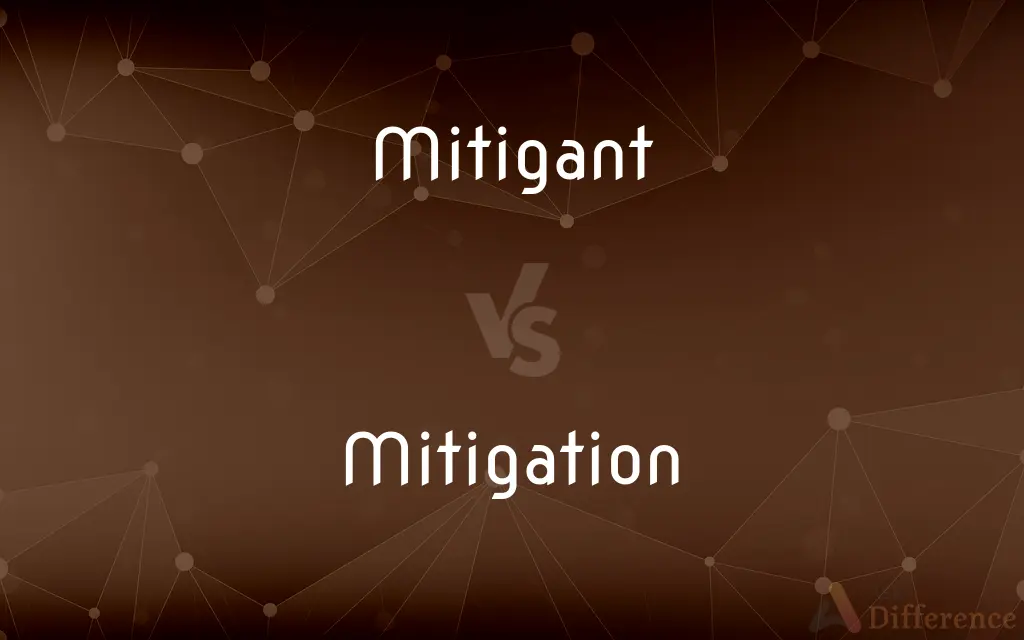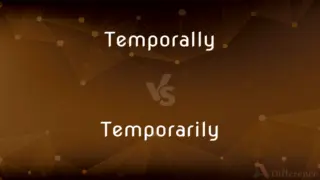Mitigant vs. Mitigation — What's the Difference?
By Tayyaba Rehman & Fiza Rafique — Updated on April 1, 2024
Mitigant refers to a factor or substance that reduces severity, while mitigation encompasses actions or strategies aimed at reducing adverse effects.

Difference Between Mitigant and Mitigation
Table of Contents
ADVERTISEMENT
Key Differences
Mitigant typically describes something—often a substance or measure—that directly lessens the intensity, severity, or harmfulness of a condition or situation. For example, in environmental science, a chemical added to reduce pollution in water can be considered a mitigant. Whereas, mitigation refers to the broader process or strategy employed to minimize negative impacts or risks. This term is widely used in various fields, from disaster preparedness to climate change, indicating comprehensive efforts to address and alleviate potential damages.
Mitigants act at a micro level, targeting specific aspects of a larger problem to diminish their effects. These can be tangible items, such as materials used in construction to dampen noise (sound mitigants), or practices, such as cooling areas prone to heat stress in urban environments. On the other hand, mitigation encompasses a macro perspective, involving planning, policies, and systematic actions aimed at preventing or reducing the overall scale of impact from potential threats or actual events.
In the context of climate change, a mitigant could be a technology that captures carbon emissions directly from the atmosphere, addressing a specific aspect of the larger issue. Mitigation, in this scenario, includes a wide array of strategies like emission reductions, reforestation, and development of renewable energy sources, aimed at combating the broader challenge of global warming.
Mitigants are often components of a larger mitigation strategy. For instance, in risk management, specific mitigants such as safety equipment or training programs are employed as part of a comprehensive mitigation plan to ensure workplace safety. Thus, while mitigants provide immediate solutions to specific problems, mitigation strategies offer a holistic approach to risk management and problem-solving.
Understanding the distinction between mitigant and mitigation is crucial for effectively addressing complex issues. Recognizing that mitigants are practical tools within broader mitigation efforts can help in the precise planning and implementation of measures to reduce adverse effects, whether in environmental management, public health, or any other field requiring risk reduction strategies.
ADVERTISEMENT
Comparison Chart
Definition
A factor or substance that directly reduces severity or intensity.
The process or strategy of reducing adverse effects or risks.
Scope
Specific, targeting individual aspects of a problem.
Broad, encompassing comprehensive efforts and strategies.
Application
Often used as a part of mitigation strategies.
Involves planning, policies, and systematic actions.
Examples
Chemicals reducing pollution, noise-dampening materials.
Climate change efforts, disaster preparedness plans.
Focus
Direct intervention on a micro level.
Overall reduction of impact on a macro level.
Compare with Definitions
Mitigant
Directly targets and diminishes adverse effects.
Shade trees are natural mitigants for urban heat islands.
Mitigation
Broad process of reducing negative impacts.
Coastal reforestation is part of erosion mitigation.
Mitigant
Reduces the intensity of a specific problem.
Antioxidants serve as mitigants against cellular damage.
Mitigation
Involves comprehensive planning and policies.
Emergency preparedness plans are crucial for disaster mitigation.
Mitigant
Substance or measure that lessens severity.
Soundproofing materials are mitigants for noise pollution.
Mitigation
Strategic approach to problem-solving.
Renewable energy development is key to carbon footprint mitigation.
Mitigant
Often part of larger strategies.
Water filters act as mitigants in broader water purification efforts.
Mitigation
Aims at preventing or reducing overall risks.
Flood barriers and zoning laws are part of flood mitigation strategies.
Mitigant
Specific and targeted in application.
Sunscreen is a mitigant against skin damage from UV radiation.
Mitigation
Can encompass various mitigants.
Mitigation of workplace hazards includes multiple safety measures.
Mitigant
Tending to mitigate.
Mitigation
To make less severe or intense; moderate or alleviate.
Mitigant
Something that mitigates; a lenitive.
Mitigation
To make alterations to (land) to make it less polluted or more hospitable to wildlife.
Mitigant
Tending to mitigate; mitigating; lenitive.
Mitigation
A reduction or decrease of something harmful or unpleasant.
Mitigation
The act of mitigating, or the state of being mitigated; abatement or diminution of anything painful, harsh, severe, afflictive, or calamitous; as, the mitigation of pain, grief, rigor, severity, punishment, or penalty.
Mitigation
To act in such a way as to cause an offense to seem less serious
Mitigation
A partial excuse to mitigate censure; an attempt to represent an offense as less serious than it appears by showing mitigating circumstances
Common Curiosities
Can mitigation efforts include multiple mitigants?
Yes, effective mitigation strategies often incorporate several mitigants to address different aspects of an issue.
How do mitigants contribute to disaster preparedness?
By providing specific tools or measures that can lessen the immediate impacts of disasters, mitigants are integral to broader preparedness strategies.
What is the goal of a mitigant?
To directly reduce the severity or intensity of specific aspects of a larger issue.
Why is mitigation important in environmental management?
It helps reduce the impact of human activities on the environment, ensuring sustainability and protecting ecosystems.
How does mitigation differ in approach from using a mitigant?
Mitigation involves a comprehensive and strategic approach to reducing overall adverse effects, while a mitigant focuses on specific problems.
What role do policies play in mitigation?
Policies provide the framework for implementing systematic actions and allocating resources for effective mitigation.
Why is it important to differentiate between mitigant and mitigation?
Understanding the distinction helps in the precise planning and implementation of targeted solutions within broader strategies.
Is there a scenario where a mitigant alone is sufficient?
For very specific, localized problems, a mitigant might be all that's needed to effectively address an issue.
How do businesses use mitigation strategies?
To minimize risks, ensure continuity, and protect employees, customers, and assets against potential threats.
What is an example of a mitigant in public health?
Vaccines serve as mitigants by directly reducing the severity or preventing specific diseases.
What makes a mitigation strategy effective?
Comprehensive planning, inclusion of effective mitigants, and adaptability to emerging risks and information.
Can technology serve as both a mitigant and part of mitigation?
Yes, technological solutions can address specific problems while also being integral to wider mitigation strategies.
How can communities participate in mitigation efforts?
Through engagement in planning processes, adoption of sustainable practices, and support for policies aimed at reducing risks.
Can mitigation change over time?
Yes, as new challenges and solutions emerge, mitigation strategies may evolve to incorporate new technologies or approaches.
How does climate change underscore the need for mitigation?
It presents global challenges that require comprehensive, strategic approaches to reduce long-term impacts and ensure planetary health.
Share Your Discovery

Previous Comparison
Protostele vs. Siphonostele
Next Comparison
Temporally vs. TemporarilyAuthor Spotlight
Written by
Tayyaba RehmanTayyaba Rehman is a distinguished writer, currently serving as a primary contributor to askdifference.com. As a researcher in semantics and etymology, Tayyaba's passion for the complexity of languages and their distinctions has found a perfect home on the platform. Tayyaba delves into the intricacies of language, distinguishing between commonly confused words and phrases, thereby providing clarity for readers worldwide.
Co-written by
Fiza RafiqueFiza Rafique is a skilled content writer at AskDifference.com, where she meticulously refines and enhances written pieces. Drawing from her vast editorial expertise, Fiza ensures clarity, accuracy, and precision in every article. Passionate about language, she continually seeks to elevate the quality of content for readers worldwide.
















































